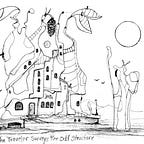When Showtime Ends
I haven’t seen a monarch butterfly in the micro-prairie for a couple of weeks now. They probably decided that it was time to head to Mexico for the winter. I wonder if they noticed that the hours of daylight and darkness are the same right now. We call this the autumnal equinox but they just know it as the last call at the milkweed nectar stand — one for the road before they head to their winter home.
Equinoxes are caused by the tilt of the earth’s axis and its orbit around the sun and signal the start of spring and fall. Equinoxes tell the flora and fauna that changes are coming. The autumnal equinox tells fall blooming flowers like the New England aster shown above that it is time to bloom. Asters are the last flowers in the micro-prairie to start blooming. Other flowers are still blooming but they are starting to wind down for winter. Early blooming plants have died back and are almost invisible in the foliage. But, that doesn’t mean there is nothing to look at in the Micro-Prairie when showtime ends. Take a look at the photo below and see how many different grasses and flowers you can see.
In the top right of the photo are the drooping heads of Canada Rye grass. Just to the left of that you can see the distinctive heads of side-oats grama in front of green milkweed leaves. Along the top left are the seed heads of garden phlox. In the lower part of the photo are the red stems of plants I called swamp weed when I was a boy on our family farm. I think it is dogbane (Apocynum cannabinum) according to information on the Prairie Moon nursery site where I got the seed. I need to hike the back pasture on the farm to see if the swamp weed is still there and if any other native plants are hanging on there.
This photo shows the blue asters and the tan seed heads of grass along with the yellow of showy goldenrod. The goldenrod is also a late bloomer but not as late as the asters. These last two images show the inspiring diversity of the Micro-Prairie. The linear shapes and tan shades of the grasses contrast with green leaves, pale purple asters and yellow, turning to brown, goldenrod. Not only is it visually diverse but it is ecologically diverse. Different species have slightly different nutrient requirements and different prime growth times. Spring blooming flowers give way to summer showtime flowers which give way to subdued fall flowers. Tall plants reach for the sun and shade loving plants grow below them. These factors even out the demand for nutrients and access to sunlight and moisture over the growing season. Each species gets its moment in the sun. Disease or adversity for one species will not spell doom for the whole micro-prairie. It is anti-fragile. It is able to regenerate itself.
One way habitats regenerate themselves is through spreading seed to new, more favorable locations. So, after the big blooms of showtime there is still a lot going on as seeds ripen and disperse. Shown above are seed heads from eight species in the micro-prairie. Clockwise from top left are purple coneflower, anise hissop, beebalm, burr grass, wild rye, black eyed susans, Joe Pye weed and garden phlox. Not only is there diversity in the size and shape of the seeds but also in the methods and timing of seed dispersal. The burr grass looks like it should hook on to my pants legs and get a free ride to another part of the garden. Oddly, it doesn’t seem to hang on to smooth fabrics. Maybe it is designed to catch in the fur of passing animals instead.
The Joe Pye weed has fluffy seed pods that shake off from the flowers easily. I walked by one and got a dusting of seeds on my jacket which I brushed off in another part of the garden. Mission accomplished for the seeds. They now have a shot at finding fertile ground that they can have to themselves. Other seeds rely on the wind or birds to move them to new ground. Milkweed which is not pictured here produces silky fluff that easily becomes airborne and can travel long distances on the wind.
Another strategy plants use is to hold onto their seeds until spring. I noticed that purple coneflowers (Echinacea purpurea) still have seeds in the seed heads in the spring. The seed heads will dry out then and the seeds will drop to the ground just as conditions are becoming favorable for germination. Also, most native plant seeds need stratification to germinate. Stratification refers to freeze/thaw cycles experienced by the seed during winter. If the seeds aren’t stratified, they won’t germinate. This prevents seed from germinating in the fall when the sprouts would be killed by frost. Stratification and other strategies give plants the tools they need to regenerate year after year.
Nature has figured out how to do some pretty amazing things without micro-chips or electronics. My goal as a gardener and steward of the earth is to leverage the things that nature does well to provide food for myself and to a create a wonderful spot to spend time. Even though showtime is over there is still a lot going on in the micro-prairie. I don’t want to miss it.
